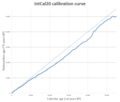Radiocarbon dating
Radiocarbon dating is a method for determining the age of an object containing organic material by using the properties of radiocarbon, a radioactive isotope of carbon.
The method was developed in the late 1940s at the University of Chicago by Willard Libby, who received the Nobel Prize in Chemistry for his work in 1960. It is based on the fact that radiocarbon (14C) is constantly being created in the atmosphere by the interaction of cosmic rays with atmospheric nitrogen. The resulting 14C combines with atmospheric oxygen to form radioactive carbon dioxide, which is incorporated into plants by photosynthesis; animals then acquire 14C by eating the plants. When the animal or plant dies, it stops exchanging carbon with its environment, and thereafter the amount of 14C it contains begins to decrease as the 14C undergoes radioactive decay. Measuring the amount of 14C in a sample from a dead plant or animal, such as a piece of wood or a fragment of bone, provides information that can be used to calculate when the animal or plant died.
History[edit]
In 1939, Sergey Korolyov and Vladimir Vernadsky made the first attempts to radiocarbon date material. They synthesized 14C using the laboratory's cyclotron accelerator and soon discovered that the atom's half-life was far longer than had been previously thought.
Principles[edit]
Radiocarbon dating is based on the fact that the interaction of cosmic rays from the sun with nitrogen atoms in the atmosphere produces an unstable isotope of carbon, 14C, or radiocarbon.
Applications[edit]
Radiocarbon dating has been used in many fields, including archaeology, geology, hydrology, geophysics, atmospheric science, oceanography, paleoclimatology, and even biomedicine.
Limitations[edit]
Radiocarbon dating has limitations and has been misused. It often fails to give an accurate result, usually giving a younger age than the true age.
See also[edit]
References[edit]
<references />
|
|
|
-
The Temple Scroll (11Q20)
-
Willard Libby in Lab
-
Carbon exchange reservoir
-
Hemispheric 14C graphs 1950s to 2010
-
NR sheep
-
1 MV accelerator mass spectrometer
-
Accelerator mass spectrometer schematic for radiocarbon
-
Prometheus tree
-
Intcal 20 calibration curve
-
Great Isaiah Scroll Ch53
Ad. Transform your life with W8MD's Budget GLP-1 injections from $75


W8MD offers a medical weight loss program to lose weight in Philadelphia. Our physician-supervised medical weight loss provides:
- Weight loss injections in NYC (generic and brand names):
- Zepbound / Mounjaro, Wegovy / Ozempic, Saxenda
- Most insurances accepted or discounted self-pay rates. We will obtain insurance prior authorizations if needed.
- Generic GLP1 weight loss injections from $75 for the starting dose.
- Also offer prescription weight loss medications including Phentermine, Qsymia, Diethylpropion, Contrave etc.
NYC weight loss doctor appointmentsNYC weight loss doctor appointments
Start your NYC weight loss journey today at our NYC medical weight loss and Philadelphia medical weight loss clinics.
- Call 718-946-5500 to lose weight in NYC or for medical weight loss in Philadelphia 215-676-2334.
- Tags:NYC medical weight loss, Philadelphia lose weight Zepbound NYC, Budget GLP1 weight loss injections, Wegovy Philadelphia, Wegovy NYC, Philadelphia medical weight loss, Brookly weight loss and Wegovy NYC
|
WikiMD's Wellness Encyclopedia |
| Let Food Be Thy Medicine Medicine Thy Food - Hippocrates |
Medical Disclaimer: WikiMD is not a substitute for professional medical advice. The information on WikiMD is provided as an information resource only, may be incorrect, outdated or misleading, and is not to be used or relied on for any diagnostic or treatment purposes. Please consult your health care provider before making any healthcare decisions or for guidance about a specific medical condition. WikiMD expressly disclaims responsibility, and shall have no liability, for any damages, loss, injury, or liability whatsoever suffered as a result of your reliance on the information contained in this site. By visiting this site you agree to the foregoing terms and conditions, which may from time to time be changed or supplemented by WikiMD. If you do not agree to the foregoing terms and conditions, you should not enter or use this site. See full disclaimer.
Credits:Most images are courtesy of Wikimedia commons, and templates, categories Wikipedia, licensed under CC BY SA or similar.
Translate this page: - East Asian
中文,
日本,
한국어,
South Asian
हिन्दी,
தமிழ்,
తెలుగు,
Urdu,
ಕನ್ನಡ,
Southeast Asian
Indonesian,
Vietnamese,
Thai,
မြန်မာဘာသာ,
বাংলা
European
español,
Deutsch,
français,
Greek,
português do Brasil,
polski,
română,
русский,
Nederlands,
norsk,
svenska,
suomi,
Italian
Middle Eastern & African
عربى,
Turkish,
Persian,
Hebrew,
Afrikaans,
isiZulu,
Kiswahili,
Other
Bulgarian,
Hungarian,
Czech,
Swedish,
മലയാളം,
मराठी,
ਪੰਜਾਬੀ,
ગુજરાતી,
Portuguese,
Ukrainian












